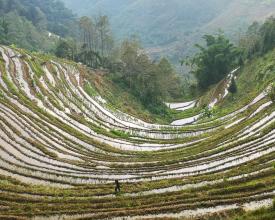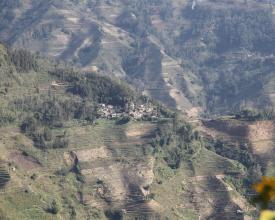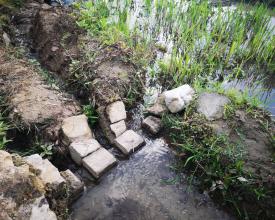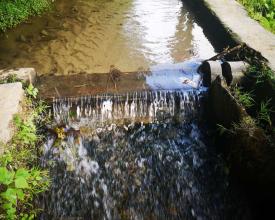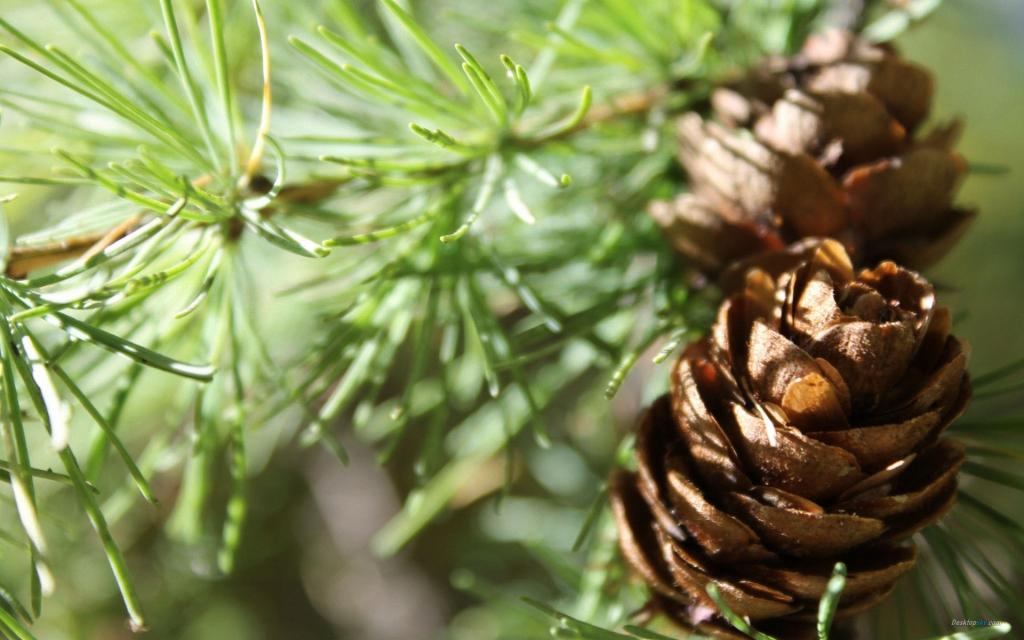Recovery of the water-wood traditional management system in the Cultural Landscape of the Honghe Hani Terraces World Heritage, China
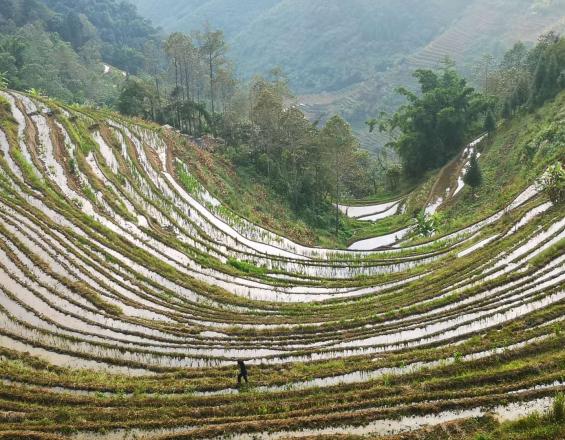
The Cultural Landscape of Honghe Hani Rice Terraces (HHRT), covering 16,603 hectares in Southern Yunnan, was inscribed in the World Heritage List in 2013 under criteria (iii) and (v). The cultivation of traditional rice has deeply moulded the landscape and shaped the farming culture of Hani people which have sustained these terraces for centuries. However, deep social changes make the sustainability of the terraces uncertain. Ecological challenges combined with loss of traditional knowledge menace the conservation of this spectacular landscape. In order to address these challenges, before the inscription of the site, Honghe prefecture developed a strategy which focuses on the recovery of the traditional water management system based on the water-wood concept and the restoration of traditional leadership. Through participatory research and a multi-level partnership, this initiative has ensured water supply to villages and sustain terraces while recovering ancient cultural practices.
Context
Challenges addressed
Yunnan province suffered from a three-year drought from 2010-2013 (environmental challenge) which impacted in agriculture irrigation, aggravating poverty (economical challenge) and disappearing traditional sacred activities related to water (social challenge) which are fundamental for the conservation of Honghe Hani Rice Terraces’ heritage values.
Location
Process
Summary of the process
The prefecture-county-township-village partnership enabled a multi-level intervention in the HHRT (BB1). Led by research institutions (independent and governmental) and with the support of local communities, a participatory investigation on the HHRT values allowed to understand the underlying issues affecting the water management system in Yakou village, as an example of the villages in the HHRT (BB2). The environmental challenge (drought) was directly linked to a social challenge (loss of traditional knowledge and governance systems). This participatory research results were the foundation for the restoration of the traditional water-woods, canals and channels (BB3).The restoration project and recognition of the traditional governance and ecological management systems gave added value to the red rice, permitting the increasing of the economic value of terrace-products (BB4), which helps addressing the economic challenge (poverty, outmigration). These building blocks supported and feedback on the establishment of a legislation and regulation system for the protection and development of the HHRT (BB5).
Building Blocks
Establishing a multi-level partnership (Prefecture-County-Township-Village)
The partnership and management system of prefecture-county-township-village is under the guidance of the Upstream competent department and cooperates with specialized research and technical institutions at different levels. It is a locally adapted innovative partnership that solves the integration between traditional and modern management, as well as international and national requirements.The World Cultural Heritage Management Administration of HHRT is responsible at prefectural level of the communication and coordination between international and national institutions. The Government of Yuanyang is the body in charge of heritage protection and management. A specialized unit, the World Heritage Management Committee of Yuanyang HHRT has been established to enforce the management plan and deal with daily affairs in the World Heritage site. Panzhihua Town and the Village Committee of Yakou are in charge of implementing conservation activities and coordinating with local stakeholders. From 2012-2018, the prefecture commissioned an investigation on the attributes and the water management system of Yakou village, in order to understand its underlying problems. The county sectors conducted the restoration of the water-wood management system based on the investigation's results.
Enabling factors
- World Heritage nomination process.
- The establishment of the World Cultural Heritage Management Administration of Honghe Hani Rice Terraces, Honghe Hani and Yi Autonomous Prefecture, China, a centralized management system which coordinates government and stakeholders at different levels.
- World Heritage Management Committee that can integrate related sectors, taking over management duties.
- In parallel, establishing close partnership with research institutions supported the integration of an international insight and the local experience.
Lesson learned
- Need of multi-sectoral cooperation and multi-party participation: Participation of local communities promotes the protection and transmission of Indigenous knowledge that relates to ecological environment conservation.
- To sustain and restore the water management system of HHRT, there is a need to involve culture and nature sectors, government and villagers as well as research institutions. Only-government-led projects would result in the loss of a sustainable driving force; the simple restoration of canals and woods would lead to aggravate conflicts of local social organizations.
- Need of a broader research: The recovery of water-wood management project is conducted only in several villages. The overall spatial distribution and conservation situation are still unclear, which needs a broader investigation and research in all 82 villages by taking one village as a basic unit.
- Need of a long-term monitoring and evaluation mechanism: Impacts of the water-wood restoration project need to be assessed in order to propose improvements.
Participatory research in cooperation with scientific institutions
Participatory research is essential when historical records lack and new concepts are introduced. The research in Yakou included three phases. The first phase aimed to understand the site and its significance. As a typical village with a well-preserved landscape of “forest-village-terrace-water system”, Yakou was selected to represent the landscape pattern of Laohuzui Area. Fieldwork was conducted both by the nomination team (Chinese Academy of Cultural Heritage) and the scientific research team (Yunnan University). The second phase focused on the restoration of Yakou’s irrigation system. Semi-structured interviews to locals, fieldwork and restoration were conducted. According to research results, the traditional water management system and related knowledge emerged as key elements in Yakou. Ditches, canals and water-woods were repaired to ensure its long-term use, and traditional ceremonies and inspection system were established by the elders. The third phase focused on the enhancement of the water management, where researchers conducted spatial research of the settlement patch distribution pattern and hydrological analysis using Geographic Information System followed by the replication of the experience in other villages.
Enabling factors
- Local research institutions are familiar with local conditions. Research requires the active involvement of local people and community to share knowledge and experience, especially oral history and unrecognized knowledge that is significant and need to connect to international and national societies.
- Combination of international perspective and local experience.
- Cooperation between public service institutions and domestic research institutes.
- Collaboration between “research institutes + public service organizations + villager organization.”
Lesson learned
- The relationship between land-use, society and culture are crucial in landscape studies. Environmental challenges might be the manifestation of social changes and new regulations (e.g. Land and water disputes could be the underlying issue).
- In the WH framework, the Outstanding Universal Value can be broad and general, but detailed features can not be neglected because these are the clue to understand the site characteristics. In Yakou, different layers of values research contribute to heritage management before and after inscription as WH. It has improved the knowledge of site managers, locals and researchers, and it is a continuing process.
- Lack of historical records and documentation is a big problem for the preservation of the traditional water culture. Too much attention has been give to the landscape views yet not sufficient attention to the nature-human interactions which produced these.
- Separate plans can not solve long-term management: Water management, conservation management and master plans should be drawn up in coordination and integrated for implementation.
Restoration of traditional water-woods, canals and channels
Water management is the core of the technology and culture in HHRT, including canals, distribution and regulation. The “water-wood” is a dynamic irrigation system based on equity and water level/water flow rate relationship. Hani people built trunk canals to retain water from the top of the mountain following topographic contours. According to the terrain, canals and branches were built vertically to channel water. To rationally allocate water, water-woods are located where terraces begin and in gentle slopes along the main vertical canals, which adjust water flow, direction and speed. Depending on the field size, each family gets adequate water. Water rights are guaranteed by the Water Committee in charge of managing canals and woods and solving disputes over water.
In Yakou, the abandonment of water-woods and canals aggravated the impacts of drought. Local managers communicated to villagers the importance of the water-wood system, and investigated why it was abandoned. The Water Committee was reorganized and a Water Chief, responsible for solving disputes and for the inspection and maintenance of the canals, was elected. A new water source was found and canals, channels and water-woods were restored systematically bringing back the water supply to the terraces.
Enabling factors
- Maintenance of the vertical pattern of “Forest-Village-Terraces-Water system” or settlement pattern of “Forest-Terrace-Village-Water," whereby people share resources and follow a common management arrangement.
- Concepts of unified planning and rational distribution.
- Collaboration between government and local community organizations with skills and cultural awareness.
- Specialized management organization and regulations, such as transparent funding, equitable distribution, system of rewards and penalties.
Lesson learned
- Integrity is an important principle for understanding the landscape, the agricultural system and its characteristics. The landscape and agricultural system are not simply composed of single elements, but these are connected in a logical way. Therefore, the recognition of the relationship between elements is the basis for research and conservation practice.
- The restoration of the water management system worked as a process of resolving disputes in the local community, especially water and farmland disputes. These disputes required and analysis of the situation of resource distribution and the reasons behind the frictions. Mutual understanding and tolerance help resolving problems and redistribute the resource rationally and objectively.
Increasing the economic value of terrace products
Red rice is the local traditional rice species in HHRT and the “rice-duck-fish” is a traditional ecological farming model which fosters biological and cultural diversity. With the assistance of governments at all levels, local authorities promote red rice cultivation and encourage ecological production with the “rice-duck-fish” system. They have announced preferential policies, and are providing a platform for cooperation with agricultural research institutes, guiding farmers to plant high-quality red rice with high market prices, restoring traditional ecological agriculture symbiosis model, and ensuring that farmland food is safe to serve as table food. Through promotion and event planning in collaboration with cooperatives, products such as red rice, terrace-cultivated fish, terrace-cultivated duck eggs are increasing the income of farmers and boosting their enthusiasm for terrace cultivation.
Large enterprises have been involved in the development of a red rice industry and brand through high-quality rice processing, setting up professional cooperatives, and adopting a large-scale business model of “companies + cooperatives + bases + farmers.” Related services, crafts and e-commerce are encouraged to promote designated villages, such as Yakou.
Enabling factors
- Policy support, including subsidies, incentives and directions to improve the economic value of agricultural products.
- Protection of basic farmland and traditional farming methods in the face of cash crop cultivation and impact of modern farming technology.
- Development of a new model of agricultural industry adapted to the market which guarantees for the continuation of the traditional rice cultivation.
- Diversification of agricultural industry attractive to workforce.
- Development of online shopping, logistics, branding and sales market.
Lesson learned
- Transportation is the main constraint for developing the local economy in remote areas, although encouraging the cultivation of traditional agricultural products and improving their economic value have achieved initial success. Profiting from transportation development and e-commerce platforms, the sales of agricultural products have increased. However, the vitality and sustainability of the rice terraces can not only rely on this, it requires an overall social and economic development to create more work opportunities for younger generations and ideas to sustain the rice terraces.
- In a modern market economy, the model of “companies + cooperatives + bases + farmers” requires a standardized product quality and follow obligatory market rules. Due to the small-scale peasant economy, products collected from different families have various quality, which is a disadvantage for large-scale production.
Legislation regulating protection and development
Previous to the inscription in the WH List, from 2000 to 2013, the HHTR World Heritage Administration and the Yuanyang Management Committee for World Heritage HHTR enacted a modern law and regulatory system to promote the sustainable development of the rice terraces based on local customary laws, such as regulations on forest protection and water resources use. They have drafted local laws, regulations and administrative measures. At the same time, they nominated the site to be protected at national level. They formulated conservation and management plans which were announced by the State Council and provincial people’s government so it could be incorporated into the national legal protection system. This would allow them to obtain State financial support. While using and maintaining the customary laws and village regulations, the conservation and management of the rice terraces are conducted according to the law and are gradually being integrated into the modern legal framework.
Enabling factors
- Modern management is integrated with community-based traditions through the setup of specialized conservation offices. These are complementary to the traditional social organization.
- A clear understanding of the current state of conservation of the rice terraces and the management system through on-site research and work.
- Issue of the Rules of Procedure and signing of the Target Responsibility which merged the traditional and modern conservation and law systems in China.
Lesson learned
- The enactment of laws and regulations is conducive to the long-term protection of the rice terraces. It is also the challenge and opportunity for the integration of traditional customary law in the minorities’ remote areas and the modern legal system under a new dual social structure combining traditional and modern management system, which exist in parallel at different levels and have not been integrated.
- In the context of the new dual social structure, the traditional community-based organization comprising “Migu-Mopi” (persons in charge of religious affairs and artisans, ditch diggers and forest rangers) is inadequate for the increasingly complex and rapidly changing modern society, as well as the maintenance and development of the rice terraces. There is an urgent need to integrate with the modern administrative system and carry out an innovative management of the rice terraces.
- Raising awareness of cultural laws and regulations needs to be undertaken among local communities. This could reduce difficulties and management costs, improving conservation efficiency.
Impacts
This project contributed to preserve the authenticity and integrity of the Honghe Hani Rice Terraces. During the process of investigation, the relationship between the water management system and its cultural and social connotations were clarified. It was found that the water-wood management system not only helps in maintaining the water supply and balance for irrigation, but it also empowers local communities and their new understandings of Indigenous knowledge and cultural identity. Under the new canal chief leadership, water flows again in its traditional distribution way, while tensions and disputes of water have been released. The village is clean and the rural environment has been highly improved. Furthermore, by recovering the water resource and restoring the water-woods, traditional water worship ceremonies have been recovered and are being sustained. Community cohesion and intergenerational transmission of traditional knowledge have been reinforced. Research institutions, local governments and stakeholders at different levels that have been involved in the research continue working in partnership on this ancient site. Now, this site that has been existing in a traditional way over centuries is adapting to the development of a modern management system, having been integrated to World Heritage processes gradually at both the international and local levels.
Beneficiaries
Local Hani communities
Sustainable Development Goals
Story
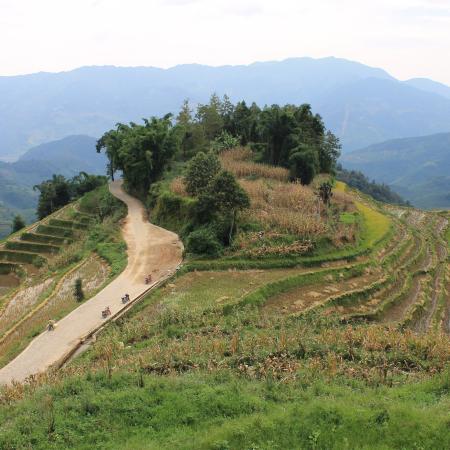
I visit Yakou every year since 2015, and it becomes better every time. It always attracts me to go back. In the past, it was not that easy to access because it is located in a remote mountain area. In 2011-2012, the local government was stepping into the last phase of the nomination process to the World Heritage (WH) List. As part of the procedure, the team in charge of drafting the nomination wanted to select several villages that could be representative of different typologies at different altitudes. In a satellite image, they found Yakou. It was a typical mountain village which posessed integrated elements of a traditional Hani village. But at that time, the village was extremely poor. People could reach it only by foot from the highway at the bottom of the mountain. The team got there on a rainy day, and found it is rich in water resources, even in a year of widespread drought. Through investigation, local researchers discovered that the village still maintained the traditional water management system which was very important to keep a sufficient water supply. But unfortunately, some traditional water-woods were already being abandoned because villagers thought they were outdated. Thus, the team and the local government decided to conduct a restoration project to help the village sustain their traditions. To encourage villagers to participate in this project, they built a road to link the village with the main highway. After several years of efforts, the village environment was enhanced. Due to the success of the water-woods restoration, other villages followed in recovering their traditional water management systems to solve problems related to society, culture and water supply, which modern administration systems were not able to deal with. In 2018, I interviewed the village head. Now, he is relieved and became a heritage inspector with 1,000 RMB (Chinese Yuan) subsidy monthly. That year, I could feel how this little quiet village, far from the city, becomes cleaner and, how their agricultural products including rice, fish and fruits are sold to big towns through an e-commerce platform. Besides, because of the good conservation of the traditional water management system, Yakou gradually attracts more visitors, villagers get alternative income and it becomes a best case to study water management system within WH. Water flows with seasonal changes… I think if WH can help people to create a better life, it is worth of undertaking the process. (Yuxin Li, Research Fellow)

